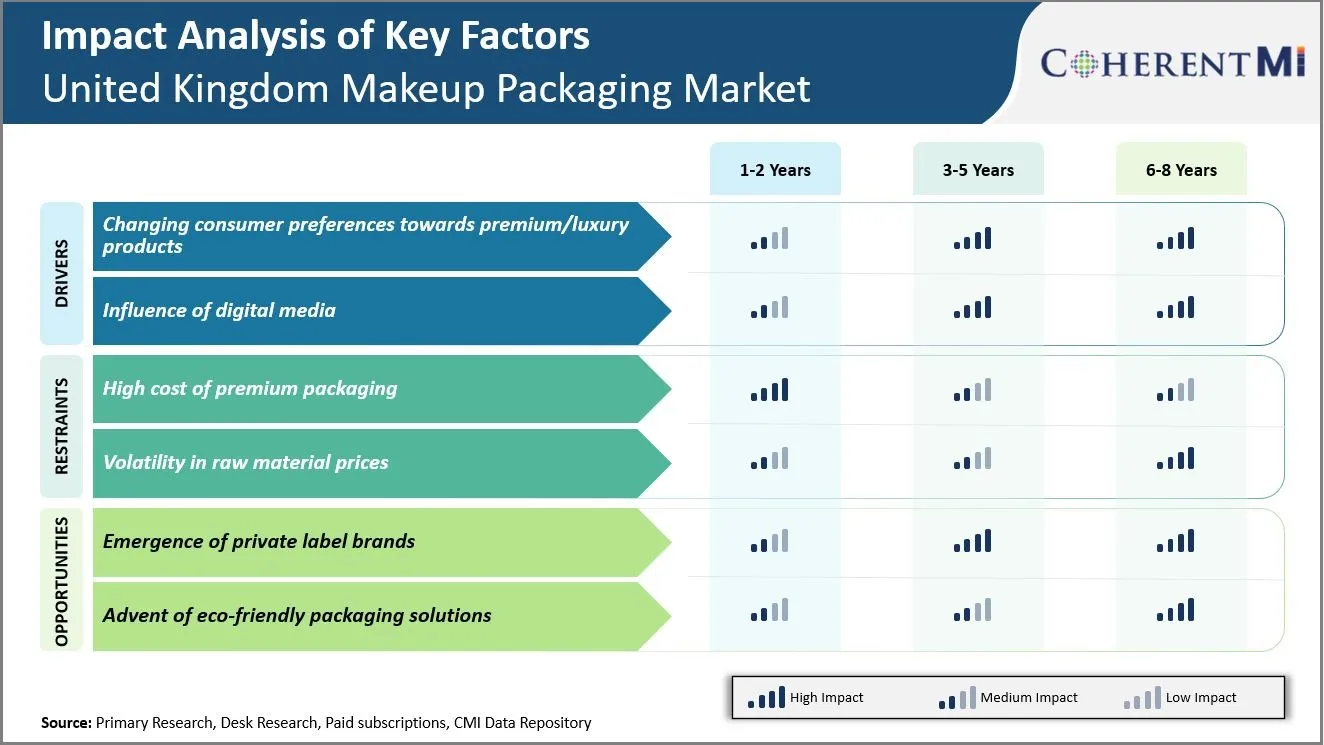United Kingdom Makeup Packaging Market Trends
Market Driver - Changing Consumer Preferences Towards Premium/Luxury Products
As consumers' incomes continue to rise in the United Kingdom, their preference towards luxury and premium products has also increased over the years. Makeup products have become a necessity across demographics and consumers now seek aspirational brands that provide premium features and luxe packaging experience. Beauty and personal care sector have witnessed a major boom in the UK with high-end products becoming popular. Consumers, especially millennials and Gen Z, are more inclined towards aesthetically appealing and beautifully crafted packaging that matches their premium makeup contents inside. Brands like Bobbi Brown, Laura Mercier, Dior, Chanel have capitalized on this consumer shift by launching their products in sleek compacts, mirrored palettes, glossy tubes and pouches covered with velvet or faux leather. Such luxury packaging creates an impression of superior quality and high-end experience for consumers. Buyers are willing to pay handsomely for aesthetically designed packaging along with enhanced formulas.
In addition, the organic beauty movement has given rise to clean makeup brands that offer toxin-free products packed in recyclable materials like glass jars and pots. These eco-friendly packaging designs have also attracted environmentally conscious millennials. Bespoke and personalized compacts are further catalyzing this premium packaging boom.
Market Driver – Influence of Digital Media
Digital platforms have transformed the way consumers engage with makeup brands and products in today's world. Beauty bloggers & influencers on Instagram, YouTube and TikTok wield immense power to promote latest launches and trends. Their glammed photos and detailed reviews heavily impact purchasing decisions of their millions of followers, most of whom are young makeup enthusiasts. Brands recognize the potential of these new media and partner with top influencers for product placements, sponsored content as well as collaborations on Collections launch. Attractive packaging takes the center stage on digital assets to grab eyeballs of online audiences. Creative unboxing and Try-on videos expose more potential customers to dramatic yet functional packaging design ideas.
Furthermore, livestream platforms like Facebook and Snapchat allow virtual makeup sessions allowing buyers to get familiar with the packaging in real-time before purchase. Advanced AR filters are also enabling consumers to try different makeup looks at home prior to buying featured products. Successful innovations in packaging on digital realm push consumers to reward such brands with their wallets.

Market Challenge – High Cost of Premium Packaging
The United Kingdom makeup packaging market faces substantial challenge from the high costs associated with premium and luxury packaging products. As the demand for higher-quality cosmetic formulas and distinctive packaging designs increases, manufacturers have had to incorporate more expensive materials like glass containers, wood components, and metallic accents into their product lines.
However, the prices that customers are willing to pay for makeup and skincare items has not kept pace with these escalating packaging costs. If packaging costs continue rising at a faster rate than price sensitivity among UK consumers, it could have the effect of pricing some prestige beauty brands out of the market. Unless makeup companies are able to drive more value from distinctive and memorable packaging designs, high packaging costs risk denting profit margins over the long term.
Market Opportunity – Emergence of Private Label Brands
The growth of private label brands in the UK makeup packaging space represents a significant market opportunity. Major retailers have recognized that offering exclusive cosmetic lines under their own brand allows them to capture a piece of the fast-growing makeup market while keeping costs lower. By handling packaging, production, and distribution in-house, retailers avoid premiums charged by major cosmetics brands and can pass higher margins onto customers in the form of competitive prices. The popularity of supermarket and pharmacy skincare and color cosmetic lines continues to increase as price-conscious UK consumers look for good quality alternatives to big name brands. If emerging private label brands consistently deliver innovative and on-trend packaging tied to high performing formulas, they could capture meaningful market share from established players in the coming years. This shifts market power to retailers and provides a new sourcing avenue for packaging manufacturers.